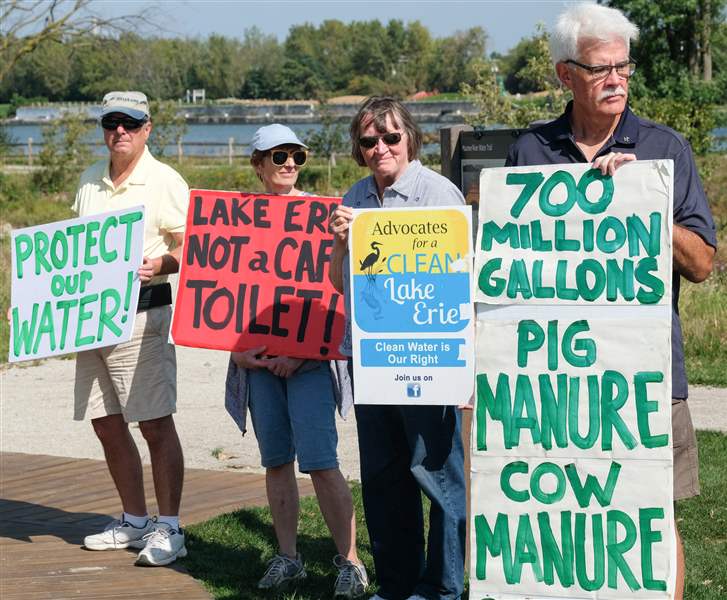
Judge dismisses lawsuit by groups seeking to clean up Lake Erie
10/4/2018
From left: David Hartman, Linda Hartman, Bev Bingle, and Sam Wright of Advocates for a Clean Lake Erie hold up signs Wednesday at Middlegrounds Metropark in Toledo.
THE BLADE/JEREMY WADSWORTH
Buy This Image
A U.S. District Court judge has thrown out a lawsuit filed by environmentalists seeking to clean up Lake Erie.
The accusations were leveled in U.S. District Court by the Environmental Law & Policy Center and its co-plaintiff, Advocates for a Clean Lake Erie.The groups contended the U.S. EPA had not been living up to requirements for Lake Erie that were established by Congress under the federal Clean Water Act back in 1972.
The lawsuit came after the 2014 water crisis, when algal toxins contaminated the tap water for hundreds of thousands of people around Toledo.
On Wednesday, U.S. District Court Judge James Carr ruled the case would be terminated. It was only recently Lake Erie was designated as impaired, Judge Carr wrote, meaning it would be too early to make a ruling on the matter in which environmentalists claim the state does not have a plan to minimize pollution levels.
“There’s really not a lot to say because the attorneys are figuring out what the next steps are going to be,” said Mike Ferner, coordinator for Toledo-based plaintiff Advocates for a Clean Lake Erie. “... We’re still in the game, and we’re not going to give up. The legal steps are still to be determined.”
With Lake Erie being designated an impaired body of water, the plaintiffs argued, “Ohio has affirmatively stated that it is not going to develop a [Total Maximum Daily Load plan] for phosphorus runoff in Lake Erie’s open waters — at least not right now,” according to court documents. However, attorneys previously claimed they never refused to do such a plan.
A Total Maximum Daily Load plan — which specifies the amount of particular pollutants an entire body can take on while still meeting water quality standards — is a requirement of the Clean Water Act, court records show. Developing such a plan can take between eight and 13 years and it could be complex for large bodies of water such as western Lake Erie, officials say.
A state does not need to submit such a plan until and unless it declares a particular body of water is impaired.
“Having designated Lake Erie’s open waters as impaired for the first time, as tardy as that may be, on May 4, 2018, Ohio still has a ‘long period of time,’ to sit on its hands before plaintiffs can plausibly allege that it has constructively submitted no TMDLs,” Judge Carr wrote. “... As unfortunate as that approach and delay have been ... the hands on the TMDL clock have just begun to turn. Given the current state of the law of constructive submission, I cannot conclude that Ohio has ‘clearly and unambiguously’ refused to submit TMDLs in violation of the Clean Water Act in perpetuity.”
While the state has not outlined a collaborative process to restore the lake, its benchmarks include a phosphorus reduction of 20 percent by 2020 and 40 percent by 2025, court records show.
Mr. Ferner said while federal court is one avenue, environmental groups will continue to pressure public officials to “do what they’re supposed to be doing.”
Messages were left with two U.S. Department of Justice attorneys, an attorney with plaintiff the Environmental Law & Policy Center, and a lawyer representing the Lucas County.
Contact Allison Dunn at adunn@theblade.com, 419-724-6506 or on Twitter @AllisonDBlade.